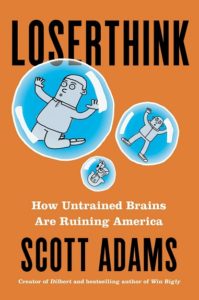 Author and cartoonist Scott Adams thinks people aren’t very good at thinking. In his latest book, Loserthink: How Untrained Brains are Ruining America, he describes several flawed thinking patterns and ways to foster more productive methods of thought and communication.
Author and cartoonist Scott Adams thinks people aren’t very good at thinking. In his latest book, Loserthink: How Untrained Brains are Ruining America, he describes several flawed thinking patterns and ways to foster more productive methods of thought and communication.
Adams’ defines loserthink as follows:
Loserthink isn’t about being dumb, and it isn’t about being underinformed. Loserthink is about unproductive ways of thinking.
Far from being immune to these unproductive ways of thinking, Adams openly admits to making ‘almost every loserthink mistake in this book, and routinely.’ Explaining why he coined the term, he writes:
By now you might be wondering why I counsel against calling people stupid while at the same time I introduce the word loserthink, which seems just as bad. The difference is that stupid refers to a person whereas loserthink applies to the technique. And keep in mind that all of us engage in loserthink sometimes. The loser part of loserthink refers to the outcome, not the DNA of the person involved. Remember to make that distinction if you use the term. Calling people stupid will not make them turn smart, but pointing out a bad technique and contrasting it with a good one can, in time, move people to a more productive way of thinking.
I am sceptical that this distinction will do much good. Associating a person with a term that includes the word ‘loser’ is unlikely to foster mutual respect, with or without Adams’ caveat. Is saying “You’re engaging in loserthink” that much better than saying “What you said is stupid”?
Adams not only describes ways of thinking as ‘loserthink’, he also labels people ‘loserthinkers’. For example, when summarising his view that developing systems is superior to focusing on specific goals, Adams writes ‘Goals are for loserthinkers. Systems are for winners.’ It’s hard not to fixate on the word loser in loserthink, when contrasted with winner. Adding ‘think’ really doesn’t add much of anything, in this context.
Loserthink and Social Media
Much of the loserthink Adams discusses in the book comes from Twitter. Anyone familiar with social media is well aware of the hostility that can erupt when people holding opposing views collide. Social media is easily one of the worst venues (if not the worst) for a debate or civil exchange of ideas. Text-based direct messaging is bad enough. Add in an anonymous crowd of observers, in competition for likes, retweets and followers, and you have a recipe for disrespectful discourse and hostility.
The problem with online discourse is not simply that people are held hostage by loserthink. That may be the case, some of the time. But even the most adept ‘winnerthinker’ is likely to succumb to the road-rage-like irrationality social media inspires. Social media platforms are not designed to foster productive discussions. As a recent documentary film entitled The Social Dilemma explained, these media platforms value engagement—quantified as ‘time on site’—not civility. A lack of civility has not deterred people from remaining on sites like Twitter and Facebook. On the contrary, it is conflict and outrage that keeps them coming back.
‘Loserthink’ is a fun book title. But despite Adams’ aim of improving public discourse, I expect his new coinage to be used as an insult by his supporters against people whom they disagree with, rather than a gateway to more productive exchanges of ideas.
Alright, enough nit-picking. Loserthink has plenty of useful insights regardless of whether you plan on referencing the concept directly.
Mind-Reading
If your opinion depends on knowing the inner thoughts of a stranger, or even someone close to you, then you might be in a mental prison. You can only know what people say and do, and even that knowledge is likely to be incomplete or out of context. And you definitely can’t tell what others are thinking as often as you believe you can. It just feels as if you have that ability. It is an illusion.
Here, Adams is describing a common cognitive distortion known as mind-reading. People who mind-read frequently show up in my office. Thanks to his large following, they also routinely show up on Adams’ Twitter account.
If you observe mind-reading, Adams suggests calling it out and, if that doesn’t help, asking mind-readers ‘how many times in their personal relationships their mates or friends have incorrectly assumed what they were thinking’. This kind of question invites people to reflect on their own experiences in order to foster empathy for the person whose mind they may be unwittingly attempting to read.
For those who would like to address their own mind-reading tendencies, a therapist can help to challenge and reframe these kinds of thought patterns (I discussed mind-reading, along with other cognitive distortions in a seminar I gave last year).
Making Mistakes
One thing I find helpful is growing old. It’s a slow process, but totally worth it compared to dying. Oldsters such as myself have vastly more experience than the young at being simultaneously wrong and also surprised about it. In time, we come to understand how easy it is to be confident in our opinions and yet spectacularly wrong. Or at least we do if we have been keeping score. And that’s exactly what I recommend doing. Make a mental note every time you find yourself being wrong about something you thought you couldn’t possibly be wrong about. Focusing on your track record can prime you to understand there can be lots of different explanations for a set of facts, and you can’t always think of them all.
The idea of recording one’s mistakes is similar to my suggestion to record your predictions and evaluate their accuracy in the future. This is a humbling experience.
Embracing Embarrassment
Put yourself in potentially embarrassing situations on a regular basis for practice. If you get embarrassed as planned, watch how one year later you are still alive. Maybe you even have a funny story because of it.
This overlaps with the above recommendation to record errors. We often predict that we will feel nervous or embarrassed in a certain situation, only to discover afterwards that it wasn’t nearly as bad as we thought (see How to Remain Fragile, for more on the benefits of seeking discomfort).
Switching Lanes
My nomination for the most loserthinkish advice in history is: “Stay in your lane.” That is the sort of advice that is better served to an enemy, not a friend. If everyone followed that advice, you wouldn’t have civilization. The world as we know it was engineered, designed, and built by people who left their lane and tried something outside their temporary skill stack. They figured it out as they went.
Adams admits that not everyone is guaranteed to benefit from sampling multiple disciplines. Some people double-down on a particular skill (e.g. basketball) and do very well. Generally, though, Adams argues that the ‘more skills you have, the more valuable you will be’.
Microsteps
In 1988, I decided to pivot from my stalled corporate career to become a cartoonist. But how does one become a cartoonist? Where do you start? What do you do first? I had no idea. The enormity of the challenge was a huge mental obstacle. So I did the smallest task I could talk myself into doing. I drove to the local art supply store and bought some high-quality pens and paper for drawing. That was all I did that day to begin working on my long-term career objective.
Later that week, I sat down with my pens and paper and started doodling, mostly to test the quality of the materials and to see how much I liked them. And that was all I did that day.
I decided to set my alarm clock half an hour earlier than normal from that day on so I would have time to draw some comics, for practice, and drink coffee before work. That became my morning ritual. Each step was tiny, but they added up. By 1989, I had assembled enough microsteps to get exactly where I wanted to be. That year, Dilbert started running in newspapers across the country.
This is a great illustration of how consistent, bite-sized progress can add up to a lot. And also a reminder to avoid fixating on the end product (e.g. becoming a cartoonist). Doing so will likely overwhelm you and discourage you from taking that much needed first step. Instead, ask yourself “What can I achieve today?”
Seeing What Isn’t There
The most common situations in which coincidences can be misleading involve your career and your personal life. When the topic has an emotional element, and you are already primed to believe something to be true, expect the environment to serve up lots of false signals.
For example, if you suspect a romantic partner of lying, suddenly you see signs of it everywhere, even if those signals are false. And if you think a particular plan in your workplace is a bad one, you will see all kinds of signals you are right, even when you are not. The more you care about a topic, the more susceptible you are to assigning meaning to coincidences. And if the situation is rich with variables, you will have plenty from which to choose.
Anyone can hypothesise about someone’s motivations or intentions (see section on mind-reading). But can you verify your assumptions? If not, why bother choosing the worst interpretation?
Afterword
I decided to feature excerpts from the book that relate to personal challenges (because those are the ones I find most interesting). However, this may unintentionally skew your perception of the book. If you are considering reading the book for yourself, it’s worth mentioning that Adams often uses political issues (e.g. climate change) to illustrate various forms of loserthink. If that sounds interesting to you, then it might be worth a read. Otherwise, you may end up skipping over large sections of the book.
More book blogs and book recommendations.



